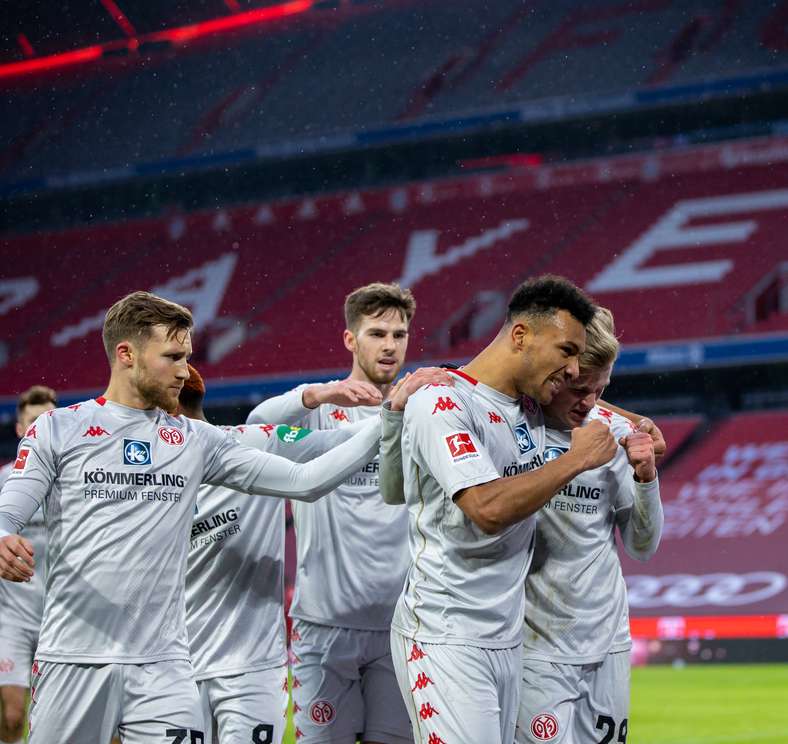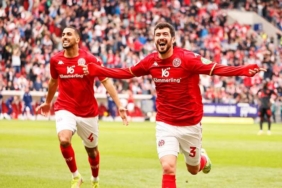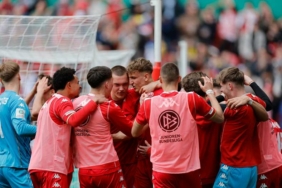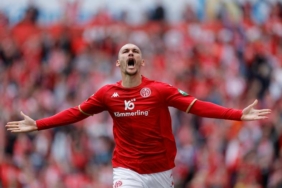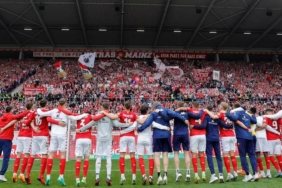One moment from the last game of the season against Eintracht Frankfurt has stuck in Bo Svensson’s mind. It came during a period of real pressure from Mainz, when Jonny Burkardt got in behind after a well-timed pass from midfield. It looked like he would be able to make it 1-0 to FSV, however as he got closer to goal, SGE defender Almamy Touré got back to dispossess him. Burkardt certainly isn’t the slowest player, but he doesn’t possess the pace that the Eintracht defender does (top speed of 35.53 km/h).
Bo Svensson watched that moment back closely and noticed that Touré wasn’t the only player in the Frankfurt team with pace to burn. In a post-match press conference, the Zerofivers boss discussed what kind of attributes he wants from potential new players. One thing is for sure: he wants pace.
“I think, in addition to what we already have, pace will be important to us,” explained the coach. “Just by comparing us to Frankfurt, they have five quick players at the back. Our players are doing a good job, but we’ve only got one really quick player there in Moussa Niakhaté. It’s definitely something that could help us. Bello isn’t the quickest, he’s got other strengths. We saw that against Frankfurt – he had a really good game, but you can play differently if you have some faster players. That’s why Jeremiah was so important to us, in the second half of last season in particular. Speed is also something you need up front and when you’re on the break. We need our lads to not get caught once they’re in behind the opposition’s defence,” said the head coach.
“We are looking at how quick potential signings are. This will be important for how we want to attack in the future. You need players with this attribute so you can press high up the pitch or be dangerous from counter-attacks.” The main Mainz attacker to take on this role this season has been Karim Onisiwo.
We are looking at how quick potential signings are
FSV do already have one player like this in their ranks and he’s joined permanently this week. The club took up the option they had to sign Delano Burgzorg, who initially arrived on loaned from Heracles Almelo in the winter. The pacy striker already showed what he is capable of in his three appearances (scoring one goal), before he contracted Covid-19 and has been out with myocarditis since.
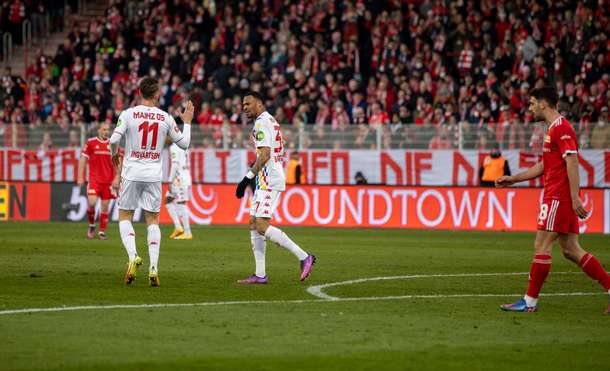
Burgzorg and Ingvartsen offering different threats
The Dutchman has already shown flashes of his skill as a front man, explained Martin Schmidt, who sees the striker in a development phase before reaching the next level. Svensson is also convinced that, when fit, the 23-year-old can make his mark in Mainz. “Delano is a type of player we haven’t had in our squad before. He’s rapid when he gets one-on-one with defenders, can play on the wing as well, and can develop to his full potential in the coming season with us.”
When asked if there was a missing place in the squad for a tall striker, much like Ádám Szalai was, the Zerofivers’ head coach said he wasn’t sure quite how tall Markus Ingvartsen was – he did note that the Denmark international had real quality as a target man. As a result of injuries, the season has not been an easy one for the man who scored a brace on the final day, but “The fact that he has still scored seven goals shows the potential he has. Marcus offers us different qualities to the strikers we currently have, and we’re sure that he’ll play a bigger part of our coming season,” said Svensson.
The fact the Dane will be at Bruchweg in 2022/23 and beyond was made public on Tuesday, as the club took up an option to sign the 26-year-old from Union Berlin permanently on a contract until 2025, after he was loaned from the Köpenick side this season.
“It would be great if we had a six-foot-six striker up top, but Markus will have to do. We aren’t just going to buy someone purely based off the fact that we need a player like that.” Ingvartsen will always have the chance to fit the bill, said Mainz’s head coach.
Tactical adjustments during the game
Svensson has played most recently with one frontman and two players playing off him in the half spaces, but has also used two out-and-out strikers often this season. Which does the coach prefer?
“We often play with one striker and two supporting players in the half spaces when we have the ball, because we noticed that it makes better use of the space. When you have three attackers up there, you have better options to play the ball. In a 3-5-2, there’s a lot less support for our strikers – they can only play amongst each other, because the midfielders are too far away from the play, as are the wing-backs. The strikers are all alone up top and have to do a lot all by themselves to create the chances. They’ve done that well this season, to be fair to them, but you’re more flexible when you have players in half-spaces and more support from your teammates. We can play in several different formations off the ball. Sometimes it worked well, but other times we had to make some changes during the game. We started off in a 3-4-3 on the ball against Hertha BSC, with a 5-4-1 off it. That didn’t work very well against them, so we decided to change it to a quicker 3-5-2, and we got a grip in the game from that,” said our head coach, going deep into detail.
You’re more flexible when you have players in half-spaces and more support from your teammates
“That ability to switch between different formations is key, so that we can be more flexible and change games in a short space of time. The one I go for at the start depends on which player we have available and what kind of team the opponent is,” Svensson added. “Our goal remains to be able to master different formations and the differing characteristics of our opponents.
One moment from the last game of the season against Eintracht Frankfurt has stuck in Bo Svensson’s mind. It came during a period of real pressure from Mainz, when Jonny Burkardt got in behind after a well-timed pass from midfield. It looked like he would be able to make it 1-0 to FSV, however as he got closer to goal, SGE defender Almamy Touré got back to dispossess him. Burkardt certainly isn’t the slowest player, but he doesn’t possess the pace that the Eintracht defender does (top speed of 35.53 km/h).
Bo Svensson watched that moment back closely and noticed that Touré wasn’t the only player in the Frankfurt team with pace to burn. In a post-match press conference, the Zerofivers boss discussed what kind of attributes he wants from potential new players. One thing is for sure: he wants pace.
“I think, in addition to what we already have, pace will be important to us,” explained the coach. “Just by comparing us to Frankfurt, they have five quick players at the back. Our players are doing a good job, but we’ve only got one really quick player there in Moussa Niakhaté. It’s definitely something that could help us. Bello isn’t the quickest, he’s got other strengths. We saw that against Frankfurt – he had a really good game, but you can play differently if you have some faster players. That’s why Jeremiah was so important to us, in the second half of last season in particular. Speed is also something you need up front and when you’re on the break. We need our lads to not get caught once they’re in behind the opposition’s defence,” said the head coach.
“We are looking at how quick potential signings are. This will be important for how we want to attack in the future. You need players with this attribute so you can press high up the pitch or be dangerous from counter-attacks.” The main Mainz attacker to take on this role this season has been Karim Onisiwo.
We are looking at how quick potential signings are
FSV do already have one player like this in their ranks and he’s joined permanently this week. The club took up the option they had to sign Delano Burgzorg, who initially arrived on loaned from Heracles Almelo in the winter. The pacy striker already showed what he is capable of in his three appearances (scoring one goal), before he contracted Covid-19 and has been out with myocarditis since.
Burgzorg and Ingvartsen offering different threats
The Dutchman has already shown flashes of his skill as a front man, explained Martin Schmidt, who sees the striker in a development phase before reaching the next level. Svensson is also convinced that, when fit, the 23-year-old can make his mark in Mainz. “Delano is a type of player we haven’t had in our squad before. He’s rapid when he gets one-on-one with defenders, can play on the wing as well, and can develop to his full potential in the coming season with us.”
When asked if there was a missing place in the squad for a tall striker, much like Ádám Szalai was, the Zerofivers’ head coach said he wasn’t sure quite how tall Markus Ingvartsen was – he did note that the Denmark international had real quality as a target man. As a result of injuries, the season has not been an easy one for the man who scored a brace on the final day, but “The fact that he has still scored seven goals shows the potential he has. Marcus offers us different qualities to the strikers we currently have, and we’re sure that he’ll play a bigger part of our coming season,” said Svensson.
The fact the Dane will be at Bruchweg in 2022/23 and beyond was made public on Tuesday, as the club took up an option to sign the 26-year-old from Union Berlin permanently on a contract until 2025, after he was loaned from the Köpenick side this season.
“It would be great if we had a six-foot-six striker up top, but Markus will have to do. We aren’t just going to buy someone purely based off the fact that we need a player like that.” Ingvartsen will always have the chance to fit the bill, said Mainz’s head coach.
Tactical adjustments during the game
Svensson has played most recently with one frontman and two players playing off him in the half spaces, but has also used two out-and-out strikers often this season. Which does the coach prefer?
“We often play with one striker and two supporting players in the half spaces when we have the ball, because we noticed that it makes better use of the space. When you have three attackers up there, you have better options to play the ball. In a 3-5-2, there’s a lot less support for our strikers – they can only play amongst each other, because the midfielders are too far away from the play, as are the wing-backs. The strikers are all alone up top and have to do a lot all by themselves to create the chances. They’ve done that well this season, to be fair to them, but you’re more flexible when you have players in half-spaces and more support from your teammates. We can play in several different formations off the ball. Sometimes it worked well, but other times we had to make some changes during the game. We started off in a 3-4-3 on the ball against Hertha BSC, with a 5-4-1 off it. That didn’t work very well against them, so we decided to change it to a quicker 3-5-2, and we got a grip in the game from that,” said our head coach, going deep into detail.
You’re more flexible when you have players in half-spaces and more support from your teammates
“That ability to switch between different formations is key, so that we can be more flexible and change games in a short space of time. The one I go for at the start depends on which player we have available and what kind of team the opponent is,” Svensson added. “Our goal remains to be able to master different formations and the differing characteristics of our opponents.

